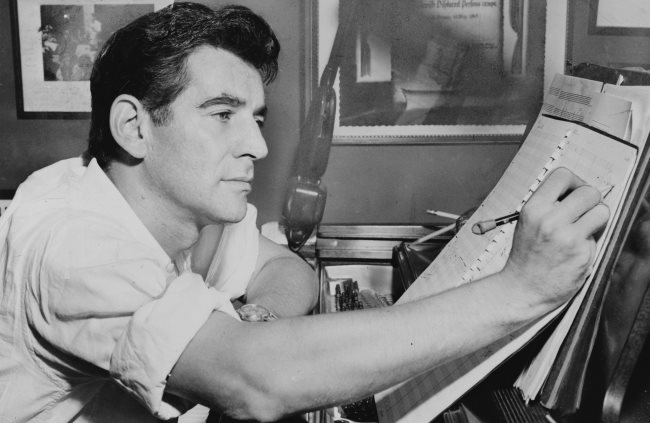Friends and Colleagues: Bernstein, Brandeis, and the 1950s
by Leon Botstein
Tonight’s concert gives voice to a web of interconnections. All five composers on the program knew one another and were, at one time or another, friends. The most active and close period of their engagement took place relatively early in Leonard Bernstein’s meteoric career—between his college days and 1957, the year West Side Story opened. Four of them (Wernick is the exception) studied at Harvard with Walter Piston, three as undergraduates. All five composers were influenced and supported by Aaron Copland and admired the music of Stravinsky. Four of them were born in and around Boston (save Berger, a New York native). And all had strong links to the Boston Symphony Orchestra and Tanglewood. All are American Jews whose careers flourished in the post-World War II era when the influence of anti-Semitism was on the wane. All five were associated with Brandeis University in its early years in the 1950s.
Leonard Bernstein served as a Visiting Professor at Brandeis from 1951 to 1956. Richard Wernick did his undergraduate studies at Brandeis, studying closely with Irving Fine. Fine taught at Brandeis from 1950 until his untimely death in 1962. Berger became the first holder of the Irving Fine Professorship at Brandeis. He and Shapero taught at Brandeis for decades until reaching retirement age. Shapero began in 1951 and Berger in 1953.
Berger was the senior member of this group. He pursued a distinguished career as a theorist and writer, and was a co-founder of the highly influential journal Perspectives of New Music. In terms of age, Fine was next in line. He was born in 1914 and was one of Leonard Bernstein’s closest friends. Bernstein was devastated by Fine’s death, as was Wernick, Fine’s protégé and eminent and devoted student. Many thought Fine the most gifted and promising of this group—the most likely to succeed Copland as the “dean” of American composers.
The most famous of them all, Bernstein, was born in 1918, two years before his close Harvard friend, Shapero. Shapero showed amazing promise early on—in his college years—as a composer. The symphony on tonight’s program was written when he was 27. It is widely considered his best work and one the great American symphonies. Bernstein was an early champion of the work. But Shapero, perhaps distracted by the security and civility of a tenured professorship, seems gradually to have stopped composing.
The four older composers often have been grouped together as exponents of a particularly American approach to musical modernism. The influence of Stravinsky, Nadia Boulanger, and, more directly, Copland encouraged the idea that new and distinctive “classical” music could actually capture the hearts and minds of the public and not inadvertently imply either a gulf between the classical and the popular or some aesthetic superiority over various forms of popular music. All five of these composers admired Marc Blitzstein. Bernstein was a particular champion. Together with Copland they held fast to an ideal of a culture particularly suited to democracy, art that was accessible to a wide literate audience, with an aesthetic cast in the lineage of Walt Whitman. The book version of Candide for the Bernstein score was written by Lillian Hellman, a writer who was controversial and outspoken, a colorful icon of liberal and progressive politics during the McCarthy era and throughout the 1950s. Fine, Wernick, and Bernstein all composed in explicitly popular genres.
The older four composers have been classified as American neo-classicists, and even as members of a “Harvard” school. More to the point is their shared penchant for transparency, compositional procedures of development, classical genres, a rhythmic vitality, and melodic instinct. If music can suggest words and ideas, this music evokes an optimism and brashness characteristic of America’s post war years—the nuclear war threat, the specter of anti-communist witch hunts, and the racial strife in the wake of the 1954 Brown vs. Board of Education notwithstanding. Wernick belongs to a subsequent generation, but he came of age in the 1950s and his lineage—his connection to Brandeis, his studies with Bernstein, Shapero, Berger, and, most importantly, Fine—place him squarely within this group, even though his music expresses its own independent, individualistic modernism.
Last but not least, all five of the composers on this program devoted a great deal of their time and energy to teaching. Bernstein became this nation’s most inspirational and influential teacher. He used the medium of television, as conductor and inspirational presence, to democratize access to the power and beauty of the classical musical tradition. Berger, Shapero, Fine, and Wernick excelled in the university classroom, and in Wernick’s case on the podium as well. Wernick has had a long and distinguished career with a substantial output of chamber and orchestral music. I was lucky enough to study with Wernick and play under him during his years on the faculty of the University of Chicago.
These five composers represent a parallel in music to the literary achievements of American Jewish writers from the same era—Saul Bellow, Louis Zukofsky, Bernard Malamud, Philip Roth, and E.L. Doctorow, to name a few. Bernstein’s place in the repertory now seems secure. But the music of Fine, Wernick, Shapero, and Berger deserve a proper and permanent place in our nation’s concert repertory.

